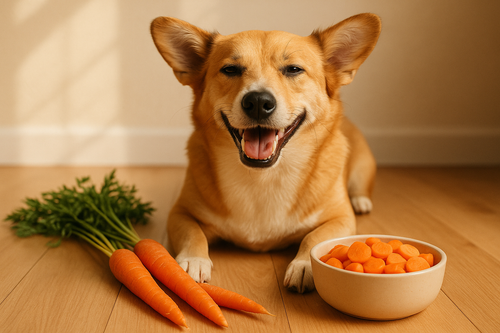
How To Decode Dog Behavior
All dogs bark, whine, and growl, but most of the time they “speak” via body language designed for dog-to-dog communication.
Think about the last time you were out with your dog. Did you ever wonder why they held their head down, stood tall around other dogs, or growled?
Learning to read and understand your dogs’ mannerisms is similar to studying a foreign language. It requires time. Communication is complex and even for dogs, can carry different meanings.
The Fundamentals of Dog Behavior
Over the centuries, dogs have become more adept in interpreting human body language, spoken words, and even hand signals. For this reason, many dogs are trained to become Therapy Dogs, assisting more than just one person in need. Therapy Dogs are in-tune with human emotions and are helpful for a variety of reasons, (that’s why we believe everyone can benefit from having a therapy dog!) When we think about all the love and affection our dogs have given us over time, it’s only fair to make the effort to better understand them!
To understand “dog” successfully, we must stretch beyond ourselves and over into canine culture.
A dog’s face, tail, ears, eyes, and mouth can speak volumes without them needing to make a sound. For example, everybody recognizes a rapidly wagging tail as a sign of canine excitement. But did you know the tail is also a primary conveyor of a dog’s social standing and mental state? As responsible dog moms and dads, we should never make the mistake of automatically interpreting tail wagging to mean friendliness.
Tail Wagging
What Does it Mean When My Dog Wags Their Tail?
A relaxed dog, comfortable in their surroundings, generally holds their tail lower and away from their body.
A frightened or submissive dog may hold his tail close to his body, tucked between his legs. Again, every dog is different, so be aware that some breeds like greyhounds, for instance, will naturally carry their tails between their legs, whether they are being submissive or not.
Smiling
What Does it Mean When My Dog Is Smiling?
Ever looked at your dog and thought, are they grinning at me? It turns out, they are! Just like humans, a dog “smiles” when their content. When a dog smiles, the muscles in their body are relaxed, which you can notice most by observing the face.
Top 3 signs of a content dog:
1. Instead of clenching their teeth together, the dog lets their mouth hang open.
2. The tongue is relaxed and hangs loosely so it’s visible over the front of their teeth.
3. The eyes are soft and the ears are straight.
Bottom line: When you see your dog smile, they are relaxed and content, and you should be, too.
Growling
What Does it Mean When My Dog is Growling?
When a dog growls, he’s letting you know he’s uncomfortable or scared.
“It’s a precursor to a bite. Never – I repeat: NEVER – punish a growl. Many dogs who have been punished for growling learn that giving a warning first doesn’t work, so they skip through the lower level communications (e.g. freezing, wide eye, lip raise, growl) warning of their intentions, and bite first instead,” Certified Trainer and Behavioral Specialist Cathy Madson with Preventive Vet said, “A growling dog is trying to tell you something – don’t teach them that this less aggressive form of communication doesn’t work and make them choose a bite instead.”
Top 3 Reasons a Dog Growls
1. Resource Guarding: Are you approaching a resource they think you’re going to take away from them, like a toy, chew or spot on the couch? Resource guarding is a natural dog behavior, and if your dog shows signs of guarding food, space, or items, this should be worked on with a certified positive reinforcement dog trainer.
2. Signs of Pain: Is someone petting them in a sensitive area, or, does that someone seem to make them uncomfortable? Growling during petting or other human touches may mean they are in pain or remembering negative experiences. First, have your veterinarian look them over to check for any underlying pain. If they receive medical clearance, a certified dog trainer can help you work on body handling desensitization.
3. Reactive Growling: Is your dog growling when they see other dogs while on a leash or when interacting with people? This could be due to reactivity, which is often based in fear. Work with a certified dog trainer on how to counter condition your dog to cope with being around people and other dogs.
What To Do When You Encounter A Fearful, Growling Dog
If a growling dog’s mouth has an elongated shape with visible gums, your dog is probably frightened and prepared to defend himself. His ears may also be flattened.
While backing away from a scared dog is your best option, it may indicate weakness to the dog. If he charges, stand still, keep your arms folded and make no eye contact (stare up at the sky, for example). Under no circumstances should you turn your back on the dog.
Standing Tall
In general, someone who wants to tell the world, “I’m in charge!” will try to make himself as big as possible. The same holds true for dogs.
A dog trying to assert itself will stand on its tippy toes, “very tall with legs quite straight,” their body tense, allowing for maximum height, says Madson. The dog may also raise their tail over their body like a flag to make certain no one fails to notice him.
“This kind of body language is usually seen along with a high and tight tail wag, forward ears, and closed mouth,” Madson said. “Body language is very contextual – you might see this tall posture in a variety of situations.
On Their Back
A scared dog will lower his body and drop his tail. If they’re extremely anxious, they’ll roll on their back, displaying their belly and throat.
“Dogs who expose their belly can be acting submissive, telling other dogs that they are no threat and don’t want to a challenge. Other times, a dog will roll over and expose its belly because they know that this often results in us humans giving them an awesome tummy scratch,” Madson said. “Dogs who feel very comfortable in their environment have no problem laying on their back and exposing their belly – which means they feel safe.”
A High, Fast Wagging Tail
Although people tend to assume a dog with a wagging tail is a happy one, they may actually be declaring, “back off!”
The faster the tail is moving, the more excited they are.
A Low, Slow Wagging Tail
Remember The Peanuts’ Charlie Brown walking home with his head hung low every day?
His body language is telling the world he’s miserable.
A dog can communicate his or her discontentment, as well, through their tail. If the tail is low and moving slowly back and forth, it could mean your dog is feeling insecure, ill or distressed.
Staring at You
A dog staring at you could mean different things, depending on whether it’s a familiar dog or not and the accompanying body language.
Direct and prolonged eye contact can be considered a challenge in dog body language, so if an unfamiliar dog is making and holding eye contact paired with tense body language, closed mouth, and high posture, you may want to beware.
“If this behavior is coming from your own dog, or a dog that is familiar with you, they are making eye contact in order to get your attention, invite interaction, or simply because they really do love you,” Madson said.
Fun fact – did you know that a mutual soft gaze with your dog actually strengthens your bond?
Your dog will also stare at you when they want to know what’s happening—whether it’s where you’re going to throw the ball or if you’re going to share a piece of your steak. This wide-eyed stare is different than the more casual look displayed when a dog is trying to figure out what you’re going to do next.
Staring at Nothing
Some dogs have an ambiguous habit of staring off into space. You may find yourself wondering, “what are they staring at?”
Well, that’s a great question!
One common explanation is that a dog may be listening or sniffing in that direction since vision plays a smaller role in perception. Maybe they heard a noise or smell something in a distance we, as pet parents, aren’t capable of hearing or smelling.
According to the AKC, another common and more serious reason a dog may stare off into space may be Canine Cognitive Dysfunction Syndrome(CDS). CDS is similar to Alzheimer’s disease in people and is becoming more common in dogs (they’re living longer than they did in the past!).
What should you do if you still can’t decode your dog’s behavior?
If you’re unsure why your dog is behaving certain ways, the best thing you can do is connect with a certified dog trainer in your area. Whether it’s a group class or private training session, a trainer can help teach you the basics of speaking and decoding dog language and behavior.
Many pet parents also turn to online resources and books to gain a better understanding. While you won’t directly see your dog’s reactions as you would in a training class, there’s still plenty of valuable takeaways.
“There are lots of wonderful books available for dog owners about canine behavior – but my all-time favorite is The Culture Clash by Jean Donaldson – I recommend it to all my training clients,” Madson said. “It’s a great introduction to the world of dog behavior and learning.”
K9 of Mine’s Dog Body Language 101 Guide is a great resource along with their mini-quiz (below). Take the quiz to see how much you know about your pup’s body language!



